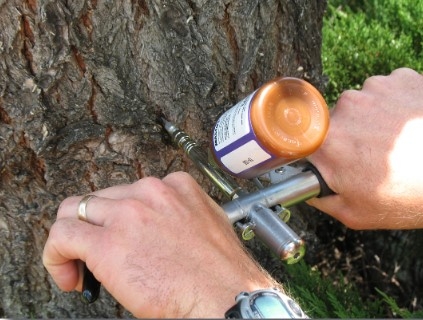
Tree Trunk Injection Review
Trunk injection is a technique for applying plant protection materials that offers an
alternative to foliar sprays or soil drenches. Among the main advantages that trunk injectionprovides over conventional methods are a higher efficiency of product delivery, reducedrisk for worker exposure, reduced risk to the environment, reduced harm to non-targetorganisms, and the possibility for use in populated areas where other methods are not anoption. Trunk injection techniques have not been optimized for use in commercialcrop production; however, there is a long history of using the method in a variety of cropand non-crop species.
According to the dictionary, the term “injection” is the act or process of forcing a
liquid medicine or drug into someone or something, usually by using a special needle. Inbotany, this term is used in a wider sense and includes any introduction of materials into aplant organ by cutting or through holes with or without force. In this sense, the earliestevidence for plant injection is from the 12th century, when Arabic horticulturists appliedperfumes, spices, dyes, and other substances through wounds in plants to affect the smell,color, or other attributes of flowers and fruits [3]. The first documented experimentationon trunk injections occurred in the 15th century by Leonardo da Vinci, who injectedarsenic and other poisonous solutions through bore holes into apple trees to render thefruit poisonous. Other experimentation until the early 1900s included injection of differentnutrient solutions such as ferrous sulphate and ferric chloride as remedies for nutritionaldeficiencies. This was followed by injection of other inorganic substances such as ironpyrophosphate, potassium cyanide, potassium phosphite and aluminum sulphate to control insects and plant
diseases. In addition to inorganic materials, organic substances including salicylic acidand plant- and microorganism-derived liquids were injected by various methods for thesame purpose.
A recently published literature review on trunk injection of citrus provides an excellent literature review and summary of pros/cons. "Trunk Injection as a Tool to Deliver Plant Protection Materials—An Overview of Basic Principles and Practical
Considerations" by Leigh Archer, Jonathan H. Crane, Ute Albrecht * has been
published in Horticulturae and is available online:
Abstract: https://www.mdpi.com/2311-7524/8/6/552
HTML Version: https://www.mdpi.com/2311-7524/8/6/552/htm
PDF Version: https://www.mdpi.com/2311-7524/8/6/552/pdf
https://forestry.usu.edu/files/utah-forest-facts/getting-chemicals-into-trees-without-spraying.pdf

